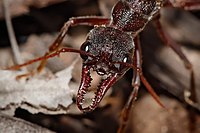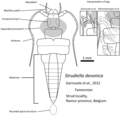Portal:Insects
The Insects Portal


Insects (from Latin insectum) are hexapod invertebrates of the class Insecta. They are the largest group within the arthropod phylum. Insects have a chitinous exoskeleton, a three-part body (head, thorax and abdomen), three pairs of jointed legs, compound eyes, and a pair of antennae. Insects are the most diverse group of animals, with more than a million described species; they represent more than half of all animal species. (Full article...)
Selected article -
Beetles are insects that form the order Coleoptera (/koʊliːˈɒptərə/), in the superorder Holometabola. Their front pair of wings are hardened into wing-cases, elytra, distinguishing them from most other insects. The Coleoptera, with about 400,000 described species, is the largest of all orders, constituting almost 40% of described insects and 25% of all known animal species; new species are discovered frequently, with estimates suggesting that there are between 0.9 and 2.1 million total species. Found in almost every habitat except the sea and the polar regions, they interact with their ecosystems in several ways: beetles often feed on plants and fungi, break down animal and plant debris, and eat other invertebrates. Some species are serious agricultural pests, such as the Colorado potato beetle, while others such as Coccinellidae (ladybirds or ladybugs) eat aphids, scale insects, thrips, and other plant-sucking insects that damage crops. Some others also have unique characteristics, such as the common eastern firefly, which uses a light-emitting organ for mating and communication purposes
Beetles typically have a particularly hard exoskeleton including the elytra, though some such as the rove beetles have very short elytra while blister beetles have softer elytra. The general anatomy of a beetle is quite uniform and typical of insects, although there are several examples of novelty, such as adaptations in water beetles which trap air bubbles under the elytra for use while diving. Beetles are holometabolans, which means that they undergo complete metamorphosis, with a series of conspicuous and relatively abrupt changes in body structure between hatching and becoming adult after a relatively immobile pupal stage. Some, such as stag beetles, have a marked sexual dimorphism, the males possessing enormously enlarged mandibles which they use to fight other males. Many beetles are aposematic, with bright colors and patterns warning of their toxicity, while others are harmless Batesian mimics of such insects. Many beetles, including those that live in sandy places, have effective camouflage. (Full article...)Did you know -
- ... that only one side of the extinct parasitoid wasp Neanaperiallus is visible in its sole fossilised specimen?
- ... that the queen ant of the Acropyga acutiventris carries a mealybug Xenococcus annandalei in her jaws on her nuptial flight?
- ... that the only known specimen of the extinct planthopper Glisachaemus jonasdamzeni is preserved with a parasitic mite?
- ... that the extinct planthopper Tainosia quisqueyae was named for the Taíno people and Hispaniola?
- ... that the discovery of the fossil giant ant Titanomyrma in Wyoming indicates that warmth-loving fauna spread through the north between Europe and America during hot spells in the Eocene?
List articles
Related portals
General images -
Selected image -

Abantiades latipennis (Lepidoptera: Hepialidae) is one of fourteen species in the Australian genus Abantiades. It thrives in regrowth forests that were previously clearfelled; the phytophagous larvae of A. latipennis feed primarily on the root systems of two species of tree, Eucalyptus obliqua (messmate stringybark) and Eucalyptus regnans (mountain ash).
WikiProjects

Main WikiProject:
Related projects:
- WikiProject Arthropods
- WikiProject Spiders
- WikiProject Animals
- WikiProject Tree of Life
- WikiProject Biology
Daughter projects:
Tasks
 |
Here are some tasks awaiting attention:
|
Associated Wikimedia
The following Wikimedia Foundation sister projects provide more on this subject:
-
Commons
Free media repository -
Wikibooks
Free textbooks and manuals -
Wikidata
Free knowledge base -
Wikinews
Free-content news -
Wikiquote
Collection of quotations -
Wikisource
Free-content library -
Wikiversity
Free learning tools -
Wiktionary
Dictionary and thesaurus




















































